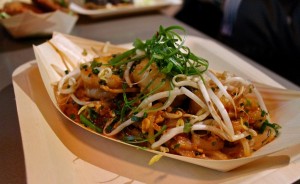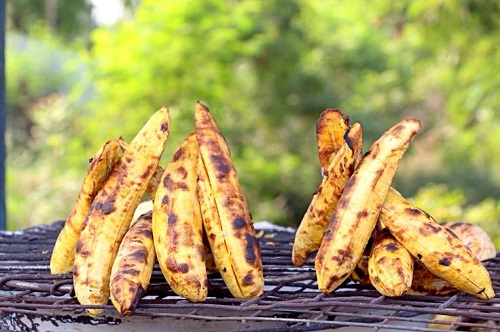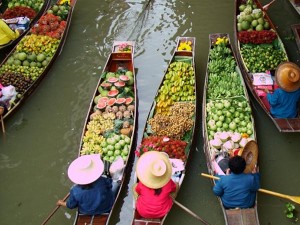The best meal I ever ate was at a roadside restaurant in the middle of Nigeria. I was in a microbus heading north through an otherworldly landscape strewn with giant boulders. It was mid-morning when we pulled over at an open-air restaurant. The counter where people were ordering was jammed. An old man, seeing my confusion, explained the menu and ordered for me.
We sat down, and the waiter brought our food: a ball of pounded yam and a bowl of egusi  soup, made with crushed melon seeds and containing a hunk of beef. The waiter asked if I wanted utensils. I looked around. No one else had them. The old man leaned over. “You know,” he remarked, “they say your food tastes better when you eat it with your hands.”
soup, made with crushed melon seeds and containing a hunk of beef. The waiter asked if I wanted utensils. I looked around. No one else had them. The old man leaned over. “You know,” he remarked, “they say your food tastes better when you eat it with your hands.”
So I waved the waiter off, broke off a piece of yam, dipped it in the soup, and scooped up a piece of the meat. It all melted together in my mouth, sweet, savory and delicious. The meat was tender and rich from stewing in a sauce.
Sometimes I still wonder why that meal was so transcendent. I was very hungry, but that can’t have been the whole reason. It must have had something to do with the experience with the people, the place, the journey itself. Of the 5,000 or so meals I’ve eaten in my life so far, only a few stand out in my mind. Most of those I’ve eaten while travelling.
I remember, for example, sitting with my wife in a field next to the Cloudy Bay Vineyards in Marlborough, New Zealand, with some cheese and bread. In the tasting room, we’d emptied our pockets and pushed a pile of change across the counter for the cheapest  bottle of sauvignon blanc they had. We lay in the grass, gazing at the mountains in the distance, sipping one of the best wines in the world. I can still taste its fruity crispness. I felt the same sense of perfection at a pizzeria in Italy and at a tiny hole-in-the-wall restaurant in Thailand.
bottle of sauvignon blanc they had. We lay in the grass, gazing at the mountains in the distance, sipping one of the best wines in the world. I can still taste its fruity crispness. I felt the same sense of perfection at a pizzeria in Italy and at a tiny hole-in-the-wall restaurant in Thailand.
Some meals, of course, are memorable for less idyllic reasons. In Tanzania, where I was teaching school, we were once served rice with a kind of cow stew poured over it. Dora, the other American teacher, leaned over to me. “Do you want these?” she asked, pointing to some large meaty tubes and a bit of stomach lining. “Sure,” I said. When no one was looking, she forked them onto my plate. I ate them happily.
Travel is written in the food in front of you…If you go to Bologna, Italy, you might order lasagna in hopes of eating an authentic Italian meal. And it is one, except that two of the main ingredients are not native to Italy. Pasta arrived from North Africa in the early Middle Ages, and the tomato which came from the Americas along with potatoes, corn, peppers, avocados and squash didn’t appear in Italian recipes until the 1700s, and was originally called pomo di moro, or ‘apple of the Moors.’
Everywhere people have travelled, conquered, or proselytized, they have left culinary tracks. The baguette is sold all across French speaking West Africa, where it’s sliced open  and slathered with meats and sauces. In former French colonies like Vietnam and Cambodia, you will find those same baguettes filled with cilantro, marinated meat and vegetables. Across East Africa, corn is a staple of local diets, often ground and made into a kind of porridge. In Somalia, the Italian and Indian influences have led to dishes such as pasta with goat meat and mild curries.
and slathered with meats and sauces. In former French colonies like Vietnam and Cambodia, you will find those same baguettes filled with cilantro, marinated meat and vegetables. Across East Africa, corn is a staple of local diets, often ground and made into a kind of porridge. In Somalia, the Italian and Indian influences have led to dishes such as pasta with goat meat and mild curries.
As I walk around my hometown, I can inhale the smells of kitchens from around the world. I stroll through Asian grocery stores and wonder at the fishballs and giant waterbugs. At a little Vietnamese restaurant, where no English is spoken, I stop in regularly for the banh mi sandwich. At an East African restaurant not far from my house, the ugali (stiff maize porridge) and nyama choma (roasted meat) bring me closer to Tanzania than I’ve been in many years.
And that is what I love most about food when opening my mouth means opening my mind, and I’m transported into another world.
By: Frank Bures – NICHE Magazine Spring 2013






























